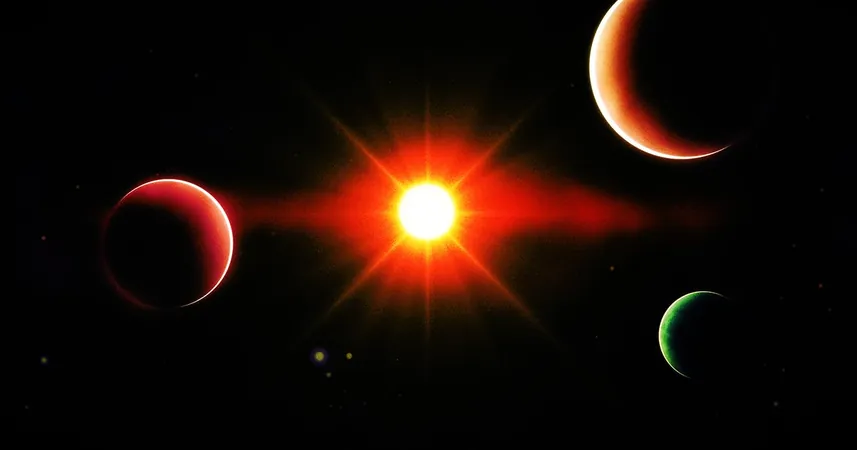
James Webb Space Telescope Revolutionizes Exoplanet Exploration with Stunning Imagery
2025-03-23
Author: Mei
Groundbreaking Achievements with JWST
In a groundbreaking achievement, astronomers utilizing the James Webb Space Telescope (JWST) have unveiled direct images of four distant planets located in the star system HR 8799, approximately 130 light-years away from Earth. This remarkable feat represents a pioneering step in exoplanet research, confirming the telescope's unprecedented capabilities in cosmic photography.
Formation of Gaseous Giants
The four gaseous giants, all in their formative stages, exist in a relatively youthful star system that is about 30 million years old. While HR 8799 has previously been studied, the latest observations—detailed in a recent study published in The Astrophysical Journal—revealed compelling evidence of significant carbon dioxide presence in their atmospheres. This finding is a promising indication that these planets may have formed similarly to the gas giants in our own solar system, namely Jupiter and Saturn.
Detection of Carbon Dioxide
“By detecting strong carbon dioxide signatures, we demonstrate that there is a substantial amount of heavier elements like carbon, oxygen, and iron present in these planets’ atmospheres,” stated William Balmer, the lead author of the study and an astrophysicist at Johns Hopkins University.
Challenges in Exoplanet Imaging
Capturing direct images of exoplanets is a rare achievement. These celestial bodies typically emit little to no light of their own, making them difficult to detect against the bright glare of their host stars. To date, astronomers have discovered only about 6,000 exoplanets, primarily by observing the slight dimming of stars as planets transit them.
Innovative Imaging Techniques
Utilizing a specialized instrument called a coronagraph, integrated into JWST's Near-Infrared Camera (NIRCam), Balmer and his team were able to block out stellar light, allowing them to focus on the light emitted from the planets themselves. “It’s like putting your thumb up in front of the sun while looking at the sky,” Balmer explained. This innovative technique enabled clear observation of the atmospheres of the distant worlds, revealing crucial insights regarding gas giant formation across the universe.
Theories of Planetary Formation
Scientists widely accept that the formation of Jupiter and Saturn occurred through a process where solid cores attracted lighter elements, gradually building mass over time. However, an alternative theory, known as disk instability, suggests that gas giants can also form directly within the dense protoplanetary disk that surrounds a newly formed star. Although this theory is subject to debate, Balmer's team's observations provide strong evidence supporting the core accretion model for the gas giants in HR 8799.
Future Research Directions
“Other indications lead us to believe that the four planets in HR 8799 likely formed using this bottom-up approach,” co-author Laurent Pueyo noted, an astronomer at the Space Telescope Science Institute in Baltimore. “While we do not yet know how common this formation process is among directly imaged planets, we propose further observations with JWST to uncover more.”
Ambitions Beyond HR 8799
The team’s ambition extends beyond just HR 8799. “We aim to capture images of additional solar systems to compare their structures and formation processes with ours,” Balmer added. “This could help us understand how unique—or typical—our solar system truly is.”
Concluding Thoughts on Exoplanet Exploration
The ongoing exploration of exoplanets continues to reshape our understanding of the forming worlds in our galaxy. As scientists delve deeper into this cosmic puzzle, they hope to unveil the complex story of planetary formation for the universe's countless star systems, making frontier discoveries that spark curiosity and awe.


 Brasil (PT)
Brasil (PT)
 Canada (EN)
Canada (EN)
 Chile (ES)
Chile (ES)
 Česko (CS)
Česko (CS)
 대한민국 (KO)
대한민국 (KO)
 España (ES)
España (ES)
 France (FR)
France (FR)
 Hong Kong (EN)
Hong Kong (EN)
 Italia (IT)
Italia (IT)
 日本 (JA)
日本 (JA)
 Magyarország (HU)
Magyarország (HU)
 Norge (NO)
Norge (NO)
 Polska (PL)
Polska (PL)
 Schweiz (DE)
Schweiz (DE)
 Singapore (EN)
Singapore (EN)
 Sverige (SV)
Sverige (SV)
 Suomi (FI)
Suomi (FI)
 Türkiye (TR)
Türkiye (TR)
 الإمارات العربية المتحدة (AR)
الإمارات العربية المتحدة (AR)